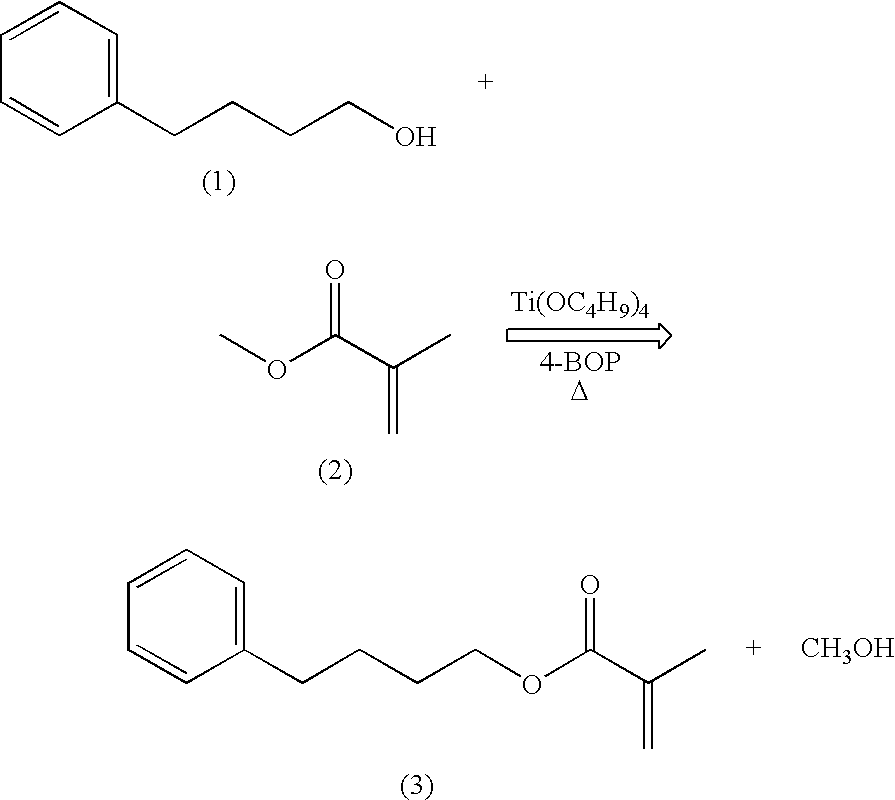Low-tack ophthalmic and otorhinolaryngological device materials
a technology of ophthalmic and otorhinolaryngological devices and low-tack acrylic, which is applied in the direction of instruments, prostheses, drug compositions, etc., can solve the problems of less desirable than other materials, explosive unfolding, and relatively low refractive index of hydrogel materials, and achieve the effect of reducing the tackiness of materials
- Summary
- Abstract
- Description
- Claims
- Application Information
AI Technical Summary
Benefits of technology
Problems solved by technology
Method used
Image
Examples
example 1
Synthesis of 4-phenylbutyl methacrylate (“PBMA”)
[0053]
[0054]A three neck round bottom flask containing a teflon coated magnetic stirring bar was successively charged with 120 mL (1.09 mol) of methyl methacrylate (2), 5.35 g (0.015 mol) of titanium tetrabutoxide (Ti(OC4H9)4), 60 mL (0.39 mol) of 4-phenyl-1-butanol (1), and 14.6 g (0.073 mol) of 4-benzyloxyphenol (4-BOP). An addition funnel, thermometer, and a short path still head with thermometer and receiver flask were placed in the flask necks. The flask was placed in an oil bath and the temperature was increased until distillation began. Methyl methacrylate (2) was placed in the addition funnel and was added dropwise at the same rate as the distillate. The reaction mixture was heated for 4 hours and then cooled to room temperature. The crude product was vacuum distilled to isolate 62.8 g (0.29 mol, 74%) of 4-phenylbutyl methacrylate (3) as a clear, colorless liquid.
example 2
Synthesis of 3-benzyloxypropyl methacrylate
[0055]
[0056]A three neck round bottom flask containing a teflon coated magnetic stirring bar was successively charged with 95 mL (0.884 mol) of methyl methacrylate (2), 4.22 g (0.012 mol) of titanium tetrabutoxide (Ti(OC4H9)4), 50 mL (0.316 mol) of 3-benzyloxy-1-propanol (1), and 14.6 g (0.073 mol) of 4-benzyloxyphenol (4-BOP). An addition funnel, thermometer, and a short path still head with thermometer and receiver flask were placed in the flask necks. The flask was placed in an oil bath and the temperature was increased until distillation began. Methyl methacrylate (2) was placed in the addition funnel and was added dropwise at the same rate as the distillate. The reaction mixture was heated for 4 hours and then cooled to room temperature. The crude product was vacuum distilled to isolate 36.5 g (0.156 mol, 49%) of 3-benzyloxypropyl methacrylate (3) as a clear, colorless liquid.
example 3
Preferred Intraocular Lens Material
[0057]A preferred intraocular lens material is presented below. All amounts are expressed as % by weight. This formulation can be initiated with a peroxy free-radical initiator, such as 1% di-(4-t-butylcyclohexyl)peroxydicarbonate (“PERK16S”)
[0058]
Ingredient% (w / w)PBMA82-84PDMS (MW = 800-1400)0.5-2 PEG(1000)DMA13-15EGDMA1UV absorber0.1-5 Blue-light absorber0.01-0.5
[0059]The chemicals are weighed, mixed, and filtered together. The resulting formulation solution is flushed with nitrogen gas and then transferred to a glovebox with a low oxygen atmosphere. The formulation is pipetted into degassed polypropylene molds. The assembled molds are then transferred to an oven and cured at 90° C. for 1 hour, followed by a post-cure at 110° C. for 1 hour. The polymer samples are removed from the molds after cooling. The low tack property of the samples is noticeable at this step of the preparation. The samples are extracted with acetone and vacuum dried. Sub...
PUM
| Property | Measurement | Unit |
|---|---|---|
| refractive index | aaaaa | aaaaa |
| Tg | aaaaa | aaaaa |
| elongation | aaaaa | aaaaa |
Abstract
Description
Claims
Application Information
 Login to View More
Login to View More - R&D
- Intellectual Property
- Life Sciences
- Materials
- Tech Scout
- Unparalleled Data Quality
- Higher Quality Content
- 60% Fewer Hallucinations
Browse by: Latest US Patents, China's latest patents, Technical Efficacy Thesaurus, Application Domain, Technology Topic, Popular Technical Reports.
© 2025 PatSnap. All rights reserved.Legal|Privacy policy|Modern Slavery Act Transparency Statement|Sitemap|About US| Contact US: help@patsnap.com



